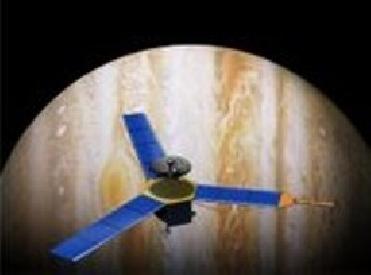
An artist's impression of the Juno spacecraft in front of Jupiter. NASA photo
WASHINGTON (BNS): It’s official. NASA is planning to conduct an unprecedented, in-depth study of the Solar System’s largest planet – Jupiter, by sending a mission there in 2011.
Titled Juno, the mission will be the first in which a spacecraft is placed in a highly elliptical polar orbit around the giant planet to understand its formation, evolution and structure, the US space agency said.
Underneath its dense cloud cover, Jupiter safeguards secrets to the fundamental processes and conditions that governed the early solar system.
The spacecraft is scheduled to launch aboard an Atlas rocket from Cape Canaveral, Florida, in August 2011, reaching the giant planet in 2016. It will orbit Jupiter 32 times, skimming about 3,000 miles over the planet's cloud tops for approximately one year. The mission will be the first solar-powered spacecraft designed to operate despite the great distance from the Sun, NASA said.
Scott Bolton, Juno principal investigator from the Southwest Research Institute in San Antonio, said Jupiter is the archetype of giant planets in the solar system and formed very early, capturing most of the material left after the Sun’s formation. "Unlike Earth, Jupiter's giant mass allowed it to hold onto its original composition, providing us with a way of tracing the solar system's history.”
Bolton said Jupiter is more than 400 million miles from the Sun or five times farther than Earth. "Juno is engineered to be extremely energy efficient."
Professor Toby Owen, co-investigator at the University of Hawaii in Honolulu, said according to Greek and Roman mythology, Jupiter's wife Juno peered through Jupiter's veil of clouds to watch her husband's mischief. "Our Juno looks through Jupiter's clouds to see what the planet is up to, not seeking signs of misbehaviour, but searching for whispers of water, the ultimate essence of life."
NASA said the spacecraft would use a camera and nine science instruments to study the hidden world beneath Jupiter's colourful clouds. The suite of science instruments will investigate the existence of an ice-rock core, Jupiter's intense magnetic field, water and ammonia clouds in the deep atmosphere, and explore the planet's aurora -- Borealis.
The science body is of the firm opinion that understanding the formation of Jupiter is essential to understand the processes that led to the creation of the entire solar system and the conditions that led to Earth and humankind.
Similar to Sun, Jupiter is composed mostly of hydrogen and helium. A small percentage of the planet is composed of heavier elements. However, Jupiter has a larger percentage of these heavier elements than the Sun, NASA said.
Professor Dave Stevenson, co-investigator at the California Institute of Technology in Pasadena, said Juno's extraordinarily accurate determination of the gravity and magnetic fields of Jupiter will enable to understand what is going on deep down the planet.
"These and other measurements will inform us about how Jupiter's constituents are distributed, how Jupiter formed and how it evolved, which is a Central part of the growing understanding of the nature of solar system”.
Juno provides a fantastic opportunity to get a picture of the structure of Jupiter in a way never possible before. "It will allow us to take a giant step forward in our understanding on how giant planets form and the role that plays in putting the rest of the solar system together," said James Green, director of NASA's Planetary Division at NASA Headquarters in Washington.
According to NASA, deep in Jupiter's atmosphere, under great pressure, hydrogen gas is squeezed into a fluid known as metallic hydrogen. At these great depths, the hydrogen acts like an electrically conducting metal which is believed to be the source of the planet's intense magnetic field. Jupiter also may have a rocky solid core at the centre.
The Juno mission is the second spacecraft designed under NASA's New Frontiers Programme. The first was the Pluto New Horizons mission, launched in January 2006 and scheduled to reach Pluto's moon Charon in 2015.
The programme provides opportunities to carry out several medium-class missions identified as top priority objectives in the Decadal Solar System Exploration Survey, conducted by the Space Studies Board of the National Research Council in Washington, NASA said.
 Previous Article
Previous Article Next Article
Next Article













The Indian Air Force, in its flight trials evaluation report submitted before the Defence Ministry l..
view articleAn insight into the Medium Multi-Role Combat Aircraft competition...
view articleSky enthusiasts can now spot the International Space Station (ISS) commanded by Indian-American astr..
view article